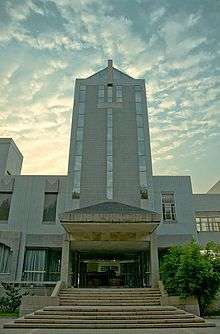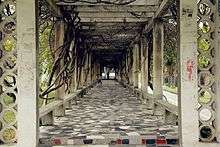China Agricultural University
China Agricultural University (CAU, Chinese: 中国农业大学; pinyin: Zhōngguó Nóngyè Dàxué; abbreviated 农大/Nóngdà) is a university in Beijing, People's Republic of China specializing in agriculture, biology, engineering, veterinary medicine, economics, management, humanities and social science. It was formed in 1995 through the merger of the Beijing Agricultural University and the Beijing Agricultural Engineering University. At present there are around 12,500 undergraduate and 7,000 graduate students in the university.[2] The new gymnasium hosted the wrestling events during the 2008 Summer Olympics. CAU is a Chinese Ministry of Education Class A Double First Class University,[3] and is designated as part of both Project 985, to create world class universities in China, and Project 211, to raise the research standards of universities.
.png) | |
Motto in English | To solve the problems of people's livelihood, to educate the talent all over the world |
|---|---|
| Type | Public |
| Established | 1905 |
Academic affiliation | Washington University in St. Louis McDonnell International Scholars Academy[1] |
| President | Sun Qixin |
Academic staff | 1,581 |
| Undergraduates | 12,500 |
| Postgraduates | 7,000 |
| Address | 17 Qinghua E Rd, Haidian Qu , , 100083 , China 40.001957°N 116.35482°E |
| Campus | Urban |
| Website | www |
History
The history of China Agricultural University can be traced back to 1905 when the College of Agriculture was founded in the former Imperial University of Peking. Beijing Agricultural University (BAU) was established in September 1949 through the merging of Peking University's College of Agriculture, Tsinghua University's College of Agriculture and North China University's College of Agriculture. BAU was listed by the State Council as one of the Top-Six Key National Universities as well as one of the Top-Ten Key Universities for further construction and improvement. In October 1952, BAU's Department of Agricultural Machinery, North China College of Agricultural Machinery and Ministry of Agriculture's Central Agricultural Mechanization School merged to form the Beijing Mechanized Agricultural College, which was renamed Beijing Agricultural Mechanization Institute (BAMI) in July 1953. The BAMI was listed by the State Council in October 1960 as one of the 64 Key National Universities and then renamed again as Beijing Agricultural Engineering University (BAEU) in 1985.
The university is the top institution in China for agricultural studies.
Faculties and colleges
- College of Agronomy
- College of Horticulture
- College of Plant Protection
- College of Biological Sciences
- College of Animal Science and Technology
- College of Veterinary Medicine
- College of Food Science and Nutritional Engineering
- College of Resources and Environmental Sciences
- College of Information and Electrical Engineering
- College of Engineering
- College of Water Conservancy and Civil Engineering
- College of Science
- College of Economics and Management
- College of Humanities and Development
- International College at Beijing
- School of Continuing Education
- Department of Arts Education and Physical Education
- Department of Ideological Education
- Yantai Academy of China Agricultural University (Yantai Campus)
- Beijing Construction University
China Agricultural University Library

China Agricultural University Library consists of two parts, east library (No.17 Qinghua Dong Lu) and west library (No.2 Yuanmingyuan Xi Lu) occupying 21,665 square meters and hosting 2774 reading seats. China Agricultural University Library (CAUL) is one of the most important libraries in agricultural education and research in China. The collections include both paper documents numbering more than 1.7 million volumes and over 1.47 million electronic documents. The collections emphasize agricultural science, biology and agricultural engineering. 116 library staff work in the library including 39 research librarians and associate research librarians. 29 library staff are post-graduates. CAUL also functions as National Agricultural Information Center of CALIS (China Academic Library and Information System) and National Foreign Textbook Center in Agriculture. Haidian District Agriculture Library is affiliated with the China Agricultural University Library. CAUL established an automatic information service system in 1995. This now runs efficiently and successfully. User education is one of the main functions of CAUL. The library provides different kinds of training courses and workshops to students and faculty every year. CAUL has been actively developing international communication and cooperation. CAUL will pursue collection development, personalized information services and resources sharing.
China Agricultural University Gymnasium
The China Agricultural University Gymnasium (simplified Chinese: 中国农业大学体育馆; traditional Chinese: 中國農業大學體育館; pinyin: Zhōngguó Nóngyè Dàxué Tǐyùguǎn) is an indoor arena located on the campus of the China Agricultural University in Beijing. Construction started the first half of 2005 and was completed in July 2007. It hosted the wrestling events of the 2008 Summer Olympics. The Gymnasium's rooftop has a staggered, stair-like design. It covers an area of 23,950 square metres and has a capacity of 8,200 which will be reduced to 6000. It will also be turned into a sports complex for students of the China Agricultural University after the Olympic Games.
Rugby union
China Agricultural University has played a key part in the reintroduction of rugby union into modern China and its subsequent growth.
Rugby re-emerged in the PRC in 1990, with a club formed at Beijing Agricultural University. A professor there, Chao Xihuang was introduced to the sport by a Japanese businessman, and set up a couple of sides.[4]
Facts


Number of students and faculty members
Full-time undergraduates: 11,838
Full-time master's degree students: 4,302
Full-time doctoral degree students: 2,732
Postdoctoral researchers: 207
Academic staff: 1,581
Numqber of degree programs
Undergraduate degree programs: 64
Master's degree programs: 171
Doctoral degree programs: 95
International university ranking
4 subjects are listed in world top 1% of ESI (Essential Science Indictors based on the ISI Web of Knowledge)
National university ranking
6 academic disciplines listed as number one among 700
Chinese universities according to the Ministry of Education
4th of total number of number one disciplines among 700
Chinese universities (Ministry of Education)
5th of the total number of National Significant Scientific Progress Awards given by the State Council
8th in the Chinese University League Table, a higher education ranking system developed by Shanghai JiaoTong
University
27th in the Chinese University League Table (China University Alumni Association)
Research publications and funding
1,682 international papers published in SCI and EI journals
Research funds in excess of 1.2 billion RMB
Sports
Host of 2008 Beijing Olympics wrestling competitions
Home of China's national female rugby team
Home of China's national youth male rugby team
Key members of the university's mountaineering team
Hold membership in the national mountaineering team
Responsible for conducting the Mount Everest portion of the 2008 Olympics torch relay.
References
- "McDonnell International Scholars Academy".
- "An overview of CAU". Archived from the original on 2011-07-07.
- "教育部 财政部 国家发展改革委 关于公布世界一流大学和一流学科建设高校及建设 学科名单的通知 (Notice from the Ministry of Education and other national governmental departments announcing the list of double first class universities and disciplines)".
- Bath, Richard (ed.) The Complete Book of Rugby (Seven Oaks Ltd, 1997 ISBN 1-86200-013-1) p65
External links
- CAU web site
- China Agricultural University Library (CAUL)
- CAU Office of International Relations
- Campus real three-dimensional map
- China agricultural university library(CAUL)web site
| Wikimedia Commons has media related to China Agricultural University. |